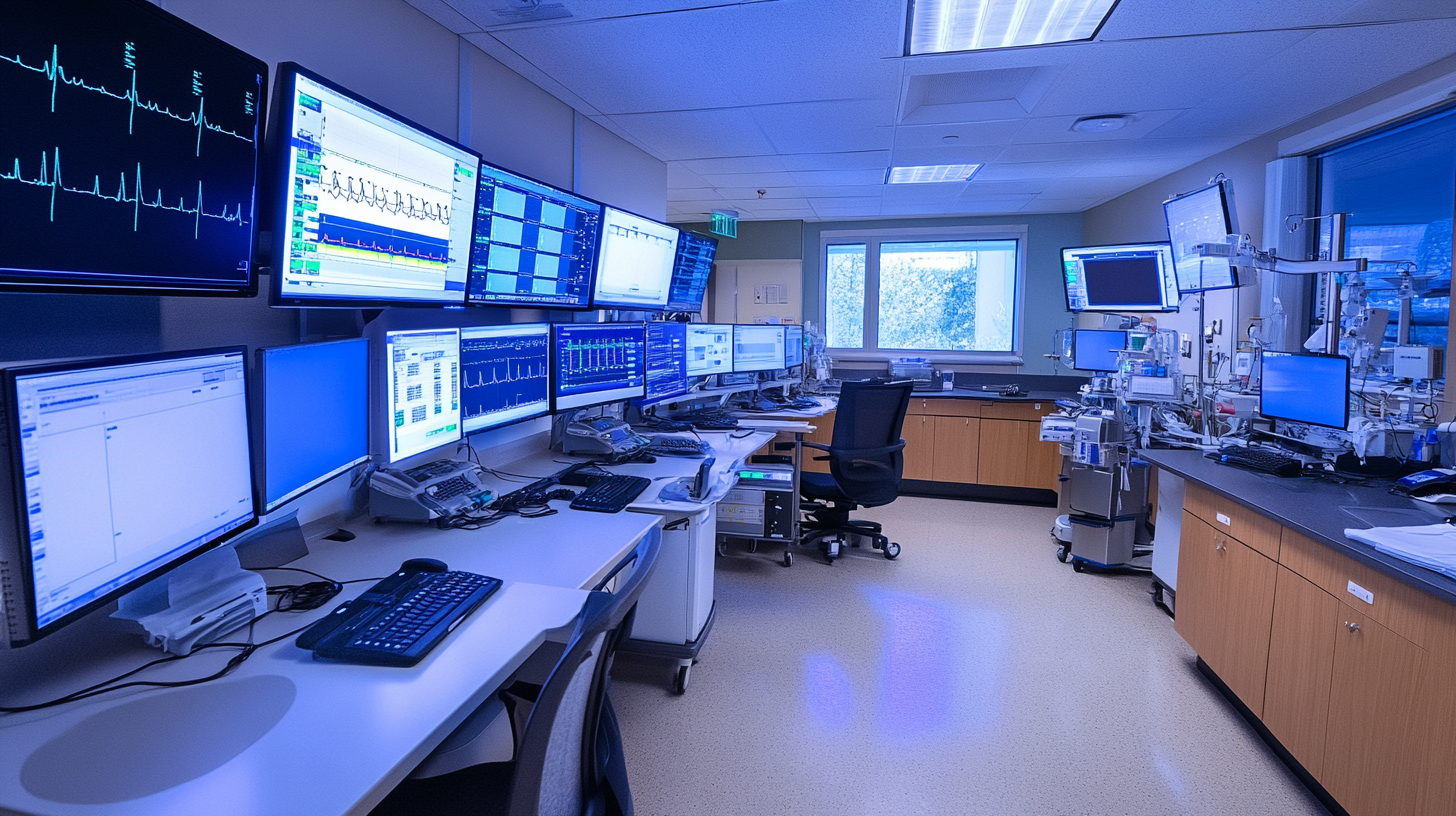10 Key Reasons Why the ICU Monitor is Essential for Patient Care Excellence in 2023
In 2023, the significance of the ICU monitor in enhancing patient care cannot be overstated. As healthcare evolves, the demand for real-time monitoring in intensive care units (ICUs) has reached unprecedented levels. According to a recent report by the American Hospital Association, approximately 30% of patients in intensive care settings experience adverse events, making effective monitoring systems crucial for timely interventions. The ICU monitor serves as an indispensable tool in this context, providing healthcare professionals with essential data that informs clinical decisions, optimizes patient outcomes, and boosts overall care efficiency.
Moreover, advancements in technology have led to the integration of sophisticated features in modern ICU monitors, such as AI-driven alerts and advanced imaging capabilities. A study published in the Journal of Critical Care in 2022 highlights that facilities utilizing advanced monitoring systems have reported a 25% reduction in hospital stays and a notable decrease in mortality rates. As the healthcare landscape shifts towards evidence-based practices, realizing the full potential of the ICU monitor is vital for any institution aiming for excellence in patient care. This blog will outline the ten key reasons underscoring the essential nature of ICU monitors in contemporary healthcare settings.

The Role of ICU Monitors in Real-Time Patient Data Collection
The integration of real-time data collection through ICU monitors plays a pivotal role in enhancing patient care, particularly in high-stakes environments such as the Intensive Care Unit (ICU). ICU monitors deliver continuous monitoring of patients' vital signs, crucial for detecting subtle changes that could indicate deterioration. For instance, the utilization of the Patient Vital Status (PVS) score represents an innovation in tracking critical patients, quantifying their physical condition based on an array of continuous variables. This approach allows healthcare professionals to respond swiftly, tailoring interventions effectively to improve patient outcomes.
Moreover, advancements in technology, such as AI-driven platforms for continuous monitoring, are transforming how data is analyzed in the ICU. These systems enable real-time assessment of video feeds and sensor data, ensuring that health professionals are equipped with timely and relevant information. Additionally, initiatives like the tele-monitoring systems for ICU ventilators exemplify the ongoing efforts to maintain vigilance in monitoring, particularly in isolation settings for COVID-19 patients. By harnessing these technologies, medical teams can better manage patient care, mitigate hospital-acquired infections, and ultimately contribute to the overall improvement of patient safety and health outcomes in the ICU.
10 Key Reasons Why the ICU Monitor is Essential for Patient Care Excellence in 2023
This pie chart illustrates the key reasons why ICU monitors are critical for enhancing patient care, highlighting the importance of real-time data collection in intensive care units.
Enhancing Patient Safety Through Continuous Monitoring
In the evolving landscape of healthcare, the importance of continuous monitoring in the Intensive Care Unit (ICU) cannot be overstated. The utilization of advanced ICU monitors is crucial for enhancing patient safety and ensuring optimal care. A recent report from the American Journal of Critical Care indicates that continuous vital sign monitoring can lead to a reduction in severe adverse events by up to 30%. This statistic highlights how real-time data can empower healthcare providers to make immediate, informed decisions to protect patients in critical conditions.
Moreover, recent findings in Nature Medicine emphasize the significance of early detection in improving patient outcomes. Continuous monitoring facilitates the prompt identification of deterioration in a patient's condition, allowing for swift intervention. For instance, data from the Clinical Medicine Insights journal reveals that continuous ECG monitoring decreases the time to intervention in arrhythmic events, which significantly lowers mortality rates in the ICU setting. This is particularly vital in an era where patient safety is paramount, and every second can make a difference.
In addition to improving immediate responses, the integration of sophisticated monitoring technology in ICUs can also enhance the overall patient experience. According to a study by the Institute for Healthcare Improvement, patients in monitored environments report higher satisfaction levels and a stronger sense of safety. The amalgamation of technology and compassion reflects a modern approach to patient care, one that prioritizes both clinical outcomes and the emotional well-being of patients. As we advance further into 2023, the role of ICU monitors remains indispensable in fostering an environment of healing and safety.
10 Key Reasons Why the ICU Monitor is Essential for Patient Care Excellence in 2023 - Enhancing Patient Safety Through Continuous Monitoring
| Key Reason | Description | Patient Safety Impact | Implementation Cost |
|---|---|---|---|
| Real-time Monitoring | Continuous observation of vital signs to detect abnormalities immediately. | High; leads to immediate response in emergencies. | Moderate |
| Data Logging | Automatic recording of patient data for accurate diagnosis. | High; enhances collaboration among healthcare teams. | Low |
| Alert Systems | Notification systems for rapid intervention when parameters are abnormal. | High; minimizes the risk of patient deterioration. | Moderate |
| Telemedicine Integration | Supports remote monitoring and consultation by specialists. | High; increases access to expert care. | High |
| Enhanced Patient Engagement | Provides patients with access to their data for better understanding. | Moderate; improves compliance with treatment. | Low |
| Improved Workflow | Streamlines the workflow for healthcare professionals. | High; reduces delays in patient care. | Moderate |
| Comprehensive Data Analysis | Analyzes trends in patient data over time. | High; aids in predictive assessments. | Moderate |
| Regulatory Compliance | Ensures adherence to healthcare regulations. | High; mitigates legal risks. | Low |
| Integration with Other Systems | Compatibility with electronic health records and other tech. | High; enhances data accessibility. | High |
| Staff Training and Efficiency | Increases staff proficiency in handling critical care situations. | High; contributes to overall care quality. | Moderate |
Facilitating Early Detection of Complications in Critical Care
In the high-stakes environment of Intensive Care Units (ICUs), monitoring technology plays an indispensable role in enhancing patient outcomes. One of the critical features of ICU monitors is their ability to facilitate early detection of complications, which is crucial for timely intervention. According to a study published in the *Critical Care Medicine Journal*, continuous monitoring can reduce mortality rates by up to 25% when alert systems are implemented effectively. This statistic underscores the importance of integrating advanced monitoring technologies in critical care settings.
Real-time data provided by ICU monitors allow healthcare professionals to swiftly identify deviations in vital signs that may indicate deteriorating patient conditions. For instance, research by the *American Journal of Critical Care* highlights that early recognition of sepsis, made possible through advanced monitoring systems, can lead to a 40% decrease in sepsis-related mortality. The capacity for continuous observation of parameters like heart rate, blood pressure, and oxygen saturation enables clinicians to act proactively, rather than reactively, thereby significantly improving patient safety.
Furthermore, the integration of artificial intelligence in monitoring systems is paving the way for enhanced predictive analytics. Recent advancements in machine learning algorithms can effectively analyze vast amounts of data to forecast potential complications. A report by the *Institute for Healthcare Improvement* suggests that employing AI-driven monitoring solutions can lead to improved clinical decision-making and reduced length of ICU stays. As healthcare technology evolves, the ICU monitor’s role as a facilitator for early complication detection becomes increasingly vital, cementing its position as a cornerstone of modern patient care excellence.

Improving Communication and Workflow Among ICU Staff
In the demanding environment of the Intensive Care Unit (ICU), effective communication and streamlined workflow are crucial for delivering excellence in patient care. ICU monitors play an instrumental role in enhancing these factors, contributing significantly to patient safety and treatment outcomes. According to a study published in the Journal of Critical Care, optimized communication among ICU staff can lead to a 30% reduction in medical error rates, showcasing the importance of reliable data delivery in critical settings.
The use of advanced ICU monitors not only provides real-time patient data but also facilitates seamless communication among healthcare providers. With features such as integrated alarm systems and data visualization tools, clinicians can quickly share and interpret vital signs and patient status. The 2022 Critical Care Technology Report identified that hospitals implementing integrated ICU monitoring systems observed a 25% improvement in workflow efficiency, allowing staff to concentrate more on patient care rather than administrative tasks.
Furthermore, data from the American Association of Critical-Care Nurses indicates that improved workflow and communication through effective monitoring systems can reduce ICU length of stay by up to 15%. This reduction is crucial as it translates not only into better resource allocation but also into faster patient recovery and a more effective use of ICU beds. In 2023, the implementation of state-of-the-art ICU monitors is more essential than ever, ensuring that healthcare teams can collaborate effectively to provide the highest standard of care.

The Impact of Advanced Monitoring Technology on Patient Outcomes
In 2023, the integration of advanced monitoring technology in Intensive Care Units (ICUs) has transformed patient care, significantly impacting outcomes. ICU monitors equipped with innovative features allow for real-time tracking of vital signs such as heart rate, blood pressure, and oxygen saturation. This continuous data stream enables healthcare providers to make informed decisions quickly, which is crucial in critical situations. The ability to monitor patients continuously ensures that any anomalies can be detected and addressed promptly, potentially saving lives.
Furthermore, advanced monitoring systems are now incorporating artificial intelligence (AI) algorithms that can analyze trends and patterns in patient data. These smart algorithms alert clinicians to potential complications before they escalate, facilitating proactive and preventive interventions. This shift from reactive to proactive care enhances patient safety and reduces the length of ICU stays, leading to better resource utilization. As hospitals strive for operational excellence, these technologies not only improve clinical outcomes but also enhance the overall experience for patients and their families.
Moreover, the user-friendly interfaces of modern ICU monitors empower healthcare professionals to interpret data more effectively. Enhanced visualization tools and customizable settings allow for the efficient prioritization of patient needs, ensuring that critical information is easily accessible. As a result, the collaborative efforts of multidisciplinary teams are amplified, fostering an environment where patient care is at the forefront. The adoption of such advanced monitoring technologies underscores the essential role they play in achieving exceptional patient care in 2023 and beyond.

